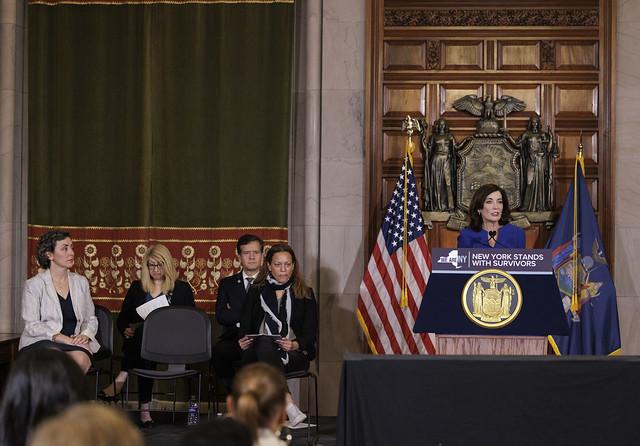New York’s recently enacted Adult Survivors Act has triggered a surge of sexual assault lawsuits, as survivors seize a rare window of opportunity to seek justice. The law, which temporarily lifts the statute of limitations for bringing claims related to decades-old abuse, has empowered countless victims to come forward and hold perpetrators accountable. As the flood of legal actions continues to make headlines, experts and advocates debate the broader implications for survivors, accused individuals, and the legal landscape nationwide. This article explores the reasons behind the wave of lawsuits filed under New York’s landmark legislation and what it means for the future of sexual assault litigation in the United States.
Adult Survivors Act Opens New Legal Pathways for Sexual Assault Victims in New York
In a groundbreaking move, New York’s Adult Survivors Act (ASA) has created a unique legal window for individuals who experienced sexual assault as adults but never filed lawsuits due to previous statute of limitations. For one year following the law’s enactment,survivors have been empowered to initiate civil claims regardless of how much time has passed since their trauma. This unprecedented reopening has led to a surge in litigation against institutions and individuals alike, shining a spotlight on a long-silenced chapter of justice. Key features driving this surge include:
- Extended legal timelines: A one-year lookback period enabling previously time-barred cases to be heard.
- Broader survivor eligibility: Inclusive of any adult victim, regardless of when the incident occurred.
- Focus on accountability: Targeting not only offenders but also organizations that enabled abuse.
Legal experts note that the law’s tailored approach has also sparked a rise in settlements and institutional reforms. Hospitals, universities, and other entities named in lawsuits are increasingly collaborating on preventive measures and support services. Below is a concise overview of reported filings since the ASA took effect:
| Category | Number of Lawsuits | Percentage |
|---|---|---|
| Educational Institutions | 120 | 35% |
| Medical Facilities | 75 | 22% |
| Religious Organizations | 60 | 18% |
| Individuals (Non-institutional) | 90 | 25% |
Impact of the Law on Statute of Limitations and Case Filings Across the State
New York’s Adult Survivors Act (ASA) has profoundly reshaped the legal landscape by temporarily lifting the statute of limitations on certain sexual assault claims, enabling survivors to file lawsuits regardless of how much time has passed since the alleged incident. This groundbreaking provision has triggered a surge in case filings, as many survivors who were previously barred by time constraints now see a legal pathway to seek justice. Courts across the state have reported a marked increase in these claims, with many cases involving institutions and prominent public figures, highlighting the law’s broad societal impact.
Key elements driving this influx include:
- A one-year “lookback window”: Survivors can file civil claims for incidents that occurred decades ago.
- Expanded eligibility: Covers a wide age range, increasing the pool of potential claimants.
- Heightened public awareness: Amplified media coverage and survivor advocacy have encouraged many to come forward.
| Statistic | Impact |
|---|---|
| 450+ | Lawsuits filed under ASA within first six months |
| 75% | Cases involving institutional defendants |
| 15 years | Average time elapsed since incident reported |
Challenges and Criticisms Surrounding the Surge in Lawsuits Under the Act
While the Adult Survivors Act has opened a notable legal avenue for victims seeking justice, it has also ignited a wave of debate among legal experts, institutions, and the public. Critics argue the sudden influx of lawsuits risks overwhelming courts already strained by backlogs, possibly delaying justice for all parties involved.Moreover, there is concern that reopening cases from decades ago could challenge the fairness of trials, given the typical lack of physical evidence and the fading memories inherent in cold cases.
Opponents of the surge emphasize a few key issues:
- Risk of Frivolous Claims: Some fear the act encourages lawsuits with weak evidence, which could unfairly damage reputations and institutions.
- Impact on Due Process: Defendants may find it arduous to mount a defense without timely evidence or witnesses available.
- Institutional Liability: Organizations worry increased litigation could lead to heavy financial consequences, affecting their ability to operate or provide services.
| Stakeholder | Main Concern | Potential Impact |
|---|---|---|
| Victims | Access to justice delayed or denied | Restoration of voices and closure |
| Court System | Docket congestion | Longer case resolution times |
| Defendants | Lack of evidence over time | Challenges in fair defense |
| Institutions | Litigation costs | Financial and reputational risk |
Recommendations for Survivors Navigating the Legal Process Amid Increased Claims
Survivors stepping forward under the Adult Survivors Act face a complex legal landscape heightened by a surge in claims. To navigate this effectively, experts emphasize the importance of early legal consultation. Lawyers can guide survivors through nuanced aspects such as statute of limitations extensions and evidence requirements, helping to create a robust case. Equally vital is documenting all details surrounding the incident to ensure no critical information is overlooked. Counseling and support groups also play a crucial role, offering emotional stability that can significantly impact the survivor’s ability to engage confidently in the legal process.
For survivors preparing to file, understanding the unique timing and procedural rules of this New York legislation is essential. The law opens a limited “look-back” window, necessitating swift action.Below is a simplified overview of key deadlines and considerations:
| Legal Step | Recommended Timeline | Purpose |
|---|---|---|
| Initial Legal Consultation | Within 30 days of decision to pursue claim | Assess case viability and evidence |
| Gathering Documentation | First 60 days | Collect medical, personal, and witness records |
| Filing the Lawsuit | Within the window period specified by the Act | Ensure claim eligibility and timing |
- Maintain Confidentiality: Share case details only with trusted parties to protect privacy.
- Stay Informed: Regularly follow updates on legal procedures and support resources.
- Seek Support: Utilize advocacy groups and counseling services to manage the emotional toll.
Final Thoughts
As the Adult Survivors Act continues to reshape the legal landscape in New York, the surge in sexual assault lawsuits underscores the profound impact of extending the window for survivors to seek justice. This legislation not only highlights the challenges faced by victims coming forward years after their abuse but also sparks ongoing debates about accountability, healing, and the limits of legal recourse.As more cases unfold under the law, its long-term effects on survivors, defendants, and the broader conversations around sexual violence will remain a critical area of focus for lawmakers, advocates, and the public alike.




